We're biking across America, teaching hands-on physics lessons at middle schools and celebrating the most innovative STEM teachers
Don't wanna be here? Send us removal request.
Photo

Radiant gradient (en route to noisy Boise) (it's really not that noisy, it's just the first city we've seen in over three weeks) #cycleforscience #day27
2 notes
·
View notes
Photo

Camping sucks don't do it // the last two days were a well-timed, much needed pick-me-up, an ever vital reminder of the good and curious people all around us Colin: found at a rest stop, moving back east after a week in Oregon; did the Northern Tier transamerica bike crossing a couple years back; gave us his pressure gauge Tom: heart surgeon turned whiskey distiller; treated us to dinner out of his camper van, a menagerie of locally grown and cultivated veggies, cheeses, breads and meats; depressed about the climate, corporatacracy, politics in his hometown Kevin: dog, Nico, had acl surgery last year; stopped to chat; grabbed us 4 bottles of water out of his truck bed Melissa: bike mechanic in Yellowstone; fixed my flat in two minutes (flat) in the middle of a canyon on a two lane highway Scott: road construction foreman with a bandana and a Jeep; gave us two lights that have 12 settings just in case #cycleforscience #day20 #soclosetoIdahowecansmellthepotatos #oregon #WestCoastSlowRide #pictapgo_app
3 notes
·
View notes
Photo

We're never gonna get out of this town but maybe we don't need to. That's Frank and he's been here some 40 years. Just took up the camera too, came over to the open land to get a better shot of the desert clouds. #cycleforscience #day15 #lakeviewday3 #oregonoutback
2 notes
·
View notes
Text
Day 5: Sacramento to Yuba City

After a lazy morning of pancakes and hanging out with my mom, we rode up the flat central valley toward Yuba City and our first warm showers host. The ride was uneventful except for the dead snakes, weird dolls at the marina I stopped at for lunch, and Rachel’s run-in with “Baby Girl” and lumberjack Greg (see photo above). Warm Showers is a website/community kind of like couch surfing, where people and families open their homes specifically to bicycle tourists. Our hosts had done their own cross-country bicycle trip -- only they took something like 140 days to do it! I wish we had that kind of time, to leisurely weave our way up and across. But 90 days’ll just have to cut it.
0 notes
Text
Day 4: Davis - Sacramento really really fast

That 7 am wake up call. I ran to Ace to pick up some more screwdrivers (turned out Home Depot’s minis were too mini for our bicycles), and also some nuts, washers, bolts, and super glue. Rachel ran to 7-11 for coffee and we shoveled oatmeal down our throats for breakfast.
Even with a viscious headwind over the causeway we made it to Cal Middle School averaging 13.4 miles per hour. I lagged a little but Rachel tore through those four miles, a little neon light at the end of the windy tunnel.
The first class was … haphazard. We definitely could have prepared better for it, but it’s hard to know how to teach a class when you just walk into it, and you’ve got no background with the kids and no real idea of what they’ve been learning.
But there were a few kids that seemed to really take to the lessons. They asked these incredibly insightful questions, they tried, failed and succeeded in tinkering with the bicycle. And we’re realizing that this trip is going to be about those students. We won’t be able to reach every kid we shake hands with. But we’re hoping we can somehow, in whatever little way, inspire a few.
Monday was the last night of home for me. Picked up some more Sol Cycles at the Urban Hive, printed for cheap by Rocket Department. Spent a couple of hours being enlightened by Pheonix, this thoughtful and relentless lady who founded LEEF Education. She’s one of those people I’m incredibly lucky to have met; her ideas will sit with me and shape me for years to come. Ash, one of the co-founders of Code for Sacramento walked in; he’s back from Iran. And we stayed with Caleb, Tyler and Ben, who I met through Fer, in the cramped and homey one-bedroom apartment they share with some pigeons and some beetles. Caleb made some hearty Jambalya with sausage and rice and veggies and spice and we curled up on rugs and in old sleeping bags and drifted off to sleep to the sound of the city.
-Elizabeth
2 notes
·
View notes
Text
Day 3: Napa - Davis

Want surreal I’ve got Dada surrealism: NBC followed us around in a red chevy convertible.
It’s strange be on the other side of the microphone, though it gives a perspective all journalists should have. A reminder that you forget what you’re saying when you speak (unless you’ve practiced your lines) and that everything is a little staged.
With the B-roll and the bike fixes, we didn’t get out of Napa until noon, but we made good time down to 12 and onto Hwy 80 and all the way to Davis, really. The central valley is flat. The only mishap -- I took a wrong turn and was trying to look up directions to cut back onto the main road and ran straight into a parked car. Well… bounced off the side of a parked car like a rubber ball and fell right into Rachel. For a moment, we were worried Rachel’s derailleur had been knocked out of alignment, but a couple’a good minutes shifting and we were back on the road … Lesson learned.
NBC’s piece will air sometime this coming week!
Coming into Davis was the homecoming I needed to really leave on this trip. We were welcomed in by this tremendous sherbert sunset, exactly like the ones I remember when I first arrived in town last April. A full, hot plate of Pad Sui at Thai Canteen with Fer and Allison, and then Rachel and I realized we needed to piece together all the Sol Cycles. All the holes needed threading, and we still hadn’t optimized the back wheel set to prevent the training wheels from popping up as it moved.
Eight hours later, we had six working Sol Cycles (minus one training wheel) and three hours until we needed to wake up and race to Sacramento to teach our first class.
Cycle for Science, folks. At least we slept well.
-Elizabeth
1 note
·
View note
Photo

Smewhere along highway 32
This is why we do this.
You can’t make it any further up the mountain ‘cause you’ve already climbed 4,500 feet on legs deader than logs; you’ve realized you missed your campground turn off (it’s probably not even open for the season); the rain’s already soaked you socks though helmet; your fingers are wrinkled and stinging; and the only way to go is to keep going up.
Well then the mountain opens its heart to you a little and it’s six miles down hill to the next campground and you’re honored with a view like this.
Don't think we could have told you before but - this is why we do this.
0 notes
Text
Day 2: Pt. Reyes - Napa.. ish

Quails are probably named as such because, man, they coo a racket in the morning. They were up collecting worms and running the kingdom long before the alarm (California, by The Kooks, set for an ambitious 7 am). We inched ourselves out of our warm sleeping bags and started packing. I’d hoped to leave camp by 8:30 -- my dad had arranged to meet us at 9 to bike to Napa -- but what with hardboiling eggs and the fog, not to mention the friends and the coffee and Rachel’s front rack falling off, we didn’t get out ‘til 9:30.

I was definitely feeling frustrated. Rachel and I have traveled before, and we’re close friends, but she hadn’t slept much in the days before we left, which made the leaving/organizing haphazard. So I was feeling a lot like a mom being taken for granted, neither of which are healthy for three-months of constant companionship. We’re in this for the long haul though, so we talked on the trail once we broke camp (Incidentally, the trail was beautiful when it wasn’t pitch black and uphill and at the end of a 3400 foot-elevation-gain day).
Because for the duration of these three months, we’re married, in it for the long haul, the good, the bad, the ugly, the stinky.
And there’s guaranteed to be lot of the first and the last (we oughta bottle the smell of our socks; like these are chemical weapons), so it’s just figuring out how to minimize the middle stuff and as with any partnership, it’ll take some work and getting used to.
Eventually, we made our way down to my pops in the Bear Valley Visitor Parking lot. Rach loaded her bike into the Prius -- my mama was going to take her to Napa to get her rack mended or replaced, since it failed two separate times on Friday.
At the visitors center, the babies are confused. I think in the world they’re carefully learning, we fail to fit any object categories ... we look like human buffalos.
For a hot minute, the bikes worked and the Prius failed, but a quick call to AAA scared the transmission into action and Rachel and my mom were on their way.
My dad and I took to the Pt. Reyes-Petaluma road, and it’s a gorgeous ride that’s chivalrous to mind and body. The hills roll with grass that’s somehow still green, the reservoir is somehow still full, the hawks circle by the dozens, their great big wings stretched out like a morning yawn.
But man man man my legs were on fire and just tired from the mountain before, and the hills were high and tall and each crest, that flat bit right as the parabola turns over, like the softest red carpet welcome.
We made it to Petaluma by 3 and ravaged meaty sandwiches from the deli. Then we clown-car piled three bikes, 17 bags and 4 adults into the family Prius and booked it to Napa, where we were staying with our first couchsurfing host. She took us in, greasy hands and stained jerseys and all, and then drove us to meet my parents for dinner.
Josh and Jenn joined us for an Italian feast accompanied by an 80’s-covers rock-and-roll band, complete with a digital drumset. Help make that goodbye good.
0 notes
Text
Day 1: The sea to the sky

A thousand feet above sea level, maybe, and our thighs are burning, so we pull off the asphalt because we can’t heave our 90-pound* bikes any further up the mountain without fast and heavy calories.
Day one and we’re climbing Mount Tam and it’s just straight on the up and up for four, five ten twenty miles (who knows how long it actually was). Rachel and I vow never to follow beauty over mountains again.*
At the top, a pint-sized public bus pulls up to the ridge and out climb a dad wearing a Bruins cap and a girl who went to Wesleyan. There’s a bus that drops you off at the top? They wish us luck; we give them stickers.
*no accurate weight available *we’re going to do it again with the Sierras; 11,000 feet of climbing in 3-4 days
Finally, we throw ourselves down the backside of the mountain toward the Pacific (our second meeting that day; our first ended with shoes, socks, cleats, gear sets, drenched in salt water, a Californian baptism before we turn east), the whole word rattling under our wheels, vibrating, buzzing with dissipated potential energy.

At the bottom, Amanda welcomes us with sour cream and onion sun chips and Paul scoops some dairy-free pesto onto a hunka bread while drinking a beer out of an egg carton. We’re just tasting the beginning of being hungry all the time.
After Stinson beach, the road runs along the water for a couple of miles and the seals are laid out like tootsie rolls on the sand bars. The rolling hills feel like wicked mountains.
Then Olema, great, tiny little town, we’re close to camp, and we’re just about out of steam. Paul and Rachel pick up a map and
then the gut-punch that Sky Camp looms 1,000+ feet above us, nestled in the fog. The sun hangs low over the hilltops and the air started to nip. At least, Rachel’s friends had pulled up around the corner ran and they offered to stack our bags in their car and carry them up the mountain.
So for the first mile it feels like our bikes are the finest carbon fiber, weig nothing, and we power up the hill. But I’m down to my lowest gear by the end of it, muscles wasted, inching upwards at 3.5 miles per darkening hour.
At the parking lot, we realize we don’t have permits and two other cars have tickets, so Rachel’s friends leave a note on the dash and we tack a warning to the post to try to catch Thomas and Max. The days’ not over yet -- there’s a 1.2 mile hike to camp, and it’s too dark by then to ride on the gravelly. The only option is to lean on the handlebars and shove them up the hill, tires and shoe soles slipping on the rocks. The path is definitely angled somewhere between 60 and 125 degrees, just walkin’ upside down.
Halfway there, Josh, Thomas and Wires caught up with us walking. They make the final stretch bearable, and when we reach camp, it’s dark, foggy and the most welcome sight we’e seen in 12 hours. We hear it was beautiful at sunset.
Hot dogs are grilled hot on charcoal, chicken sausage loaded on, zucchini crisped and buns toasted. We feasted, we made Dionysus proud.
Josh’s Google Fire Thrower, or whatever it was called, lit up the fog to the level of a dim bar bathroom, only it smelled like salt and pines instead of sweat and beer. You could see the little water droplets dip and spin in the air, a billion elegant ballerinas.
[cool video coming with better internet]
I went to bed full, tired, a little fed up, a little cold, and a little confused that this big thing we’d talked into the ground had actually begun.
-Elizabeth
1 note
·
View note
Text
Preparation
Hey friends!
Rachel and I are going to try to post as much as possible on here. I’ll be writing more of the daily doses, but we’re both going to be chiming in, posting photos, etc. We’ve got a few lined up before we go into the Sierra Nevadas, since we’re not sure when we’ll have service again. Hope you enjoy!
We’ve been slowly collecting our gear since January but during the last three weeks, Rachel and I must’ve made 25 trips to REI (not to mention local bike shops, grocery stores, and pharmacies). I listed and weighed all the stuff I’m bringing with me (note the items that have already been crossed out and thus sent back with my mother (thanks mom!)).
Check it out here
Rachel’s carrying other essentials, like first aid.

Check out our Sol Cycle tool box! Fits snug on the back rack of my bike.

Here’s how I’ve got things stacked:
4 panniers, all Arkel Orca’s. I got those instead of the traditional Ortliebs because they have pockets on the front. Plus with patches gorilla glued on the front, they look primo.
I can’t keep anything straight, so I sorted my bags and wrote what I put in them on the neon visibility tape I ran down the outside of the panniers. Roughly, the front packs have food + hammock (food for the body, food for the soul) on one side and bike and camera gear on the other. I’ve got Surly Nice front and back racks, a ton of surface area on the top, so I strapped my Voltaic solar panel to the top with a couple’a bungee cords. The front panniers sit nicely loaded lower down on the bottom rungs.
On the back, I have clothes + electronics in a third bag, and the miscellaneous camping gear in the fourth. The book I brought? Desert Solitaire, by Edward Abbey. Here’s a quote that’s a bit of a mantra for me for the trip. In context, he’s out in his trailer in the Utah desert, miles from any other human.
“.. but instead of loneliness I feel loveliness. Loveliness and a quiet exultation.”
As I finish books, I’m shipping them back home and either finding a new one where I am, or having my mom ship me one from a box of good reads I prepared before I left. I didn’t bring a Kindle because Iike the brush of the paper turning the page, and because I associate the knowledge gained with the places I’ll be when I read them, and I want to be able to go straight back to that.
Yeahhhh I’ve got a ton of stuff. There’s always a trade-off between weight and comfort, and since we’ll be on the road for three months, I’m learning to love the little things: a couple extra pounds is worth it.
Other things I did to prepare: road my bike most days in the two weeks before leaving; road it once fully loaded; got it properly fitted at Bicycle Outfitters in Los Altos; did some squats, lunges and deadlifts at the gym; spent time with friends and family; started packing for grad school.
Leaving home is always hard for me. I’m a homebody, and I crave the warmth and sense of belonging that’s hard to find outside the house I grew up in. I just found out that, with Cornell starting in late August, once we finish this adventure, I’ll only have a few weeks at home before I have to pick up and drive back across the country to New York.
That’s tough.
Here’s to finding another home on the road.
-Elizabeth
0 notes
Text
Cycle for Science begins!
Hey all!
Cycle for Science is off, zoom!

At the time of this posting, we have ridden just about 200 miles and tonight we’re posting up in Yuba City. We’re going to update here about every 2-3 days, but we’re a little behind. Bear with us because it’s been an incredible journey so far, and we haven’t even really gone anywhere yet. Our bodies already seem to have adjusted to 50-60 mile days (at least, when it’s flat). But we hit the Sierras this weekend, California’s bony backbone, a ten thousand-foot climb.
See I even broke Google trying to figure out the best route:
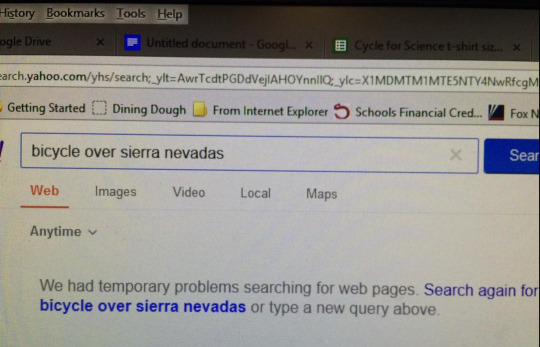
We’ve got a couple of posts written, and we’re going to play catch up tomorrow and Thursday in Chico. The stories: they’re coming.
In the meantime, a few quick tidbits to tide you over:
- On Sunday, we .... well, it’s a secret now, but it involves a red Chevy convertible. We say no more.
- On Monday, we taught our first class! Cal Middle School and Ms. Mafe Aguilar let us take over fifth period. Thirty 7th graders and five Sol Cycles zipped around the front of the school. Photos and details on that coming soon.
- Then a middle school science teacher recognized Rachel and her Cycle for Science stickers in a bike shop. “You guys on NPR?” hollered a bike mechanic from the other room.
- Yesterday, Rachel made friends with a pitbull in an orchard today, who was jealously eyeing the bacon bits in her sandwich. Farmer Greg called off Baby Girl and invited her inside to refill water (I was maybe five miles back toodling along after a leisurely lunch at a dock on the Sacramento River, where each station was marked by a rag doll).
Farmer Greg was a two time lumberjack world champion (more on this in Rachel’s upcoming post), and here he is in his infinite glory, with the infamous Baby Girl and his housemate Steven.

- And this morning, we squeezed in a teaching lesson with the grandkids of our amazing hosts (Rick and Sharon from Warm Showers, check out their cross country blog!)
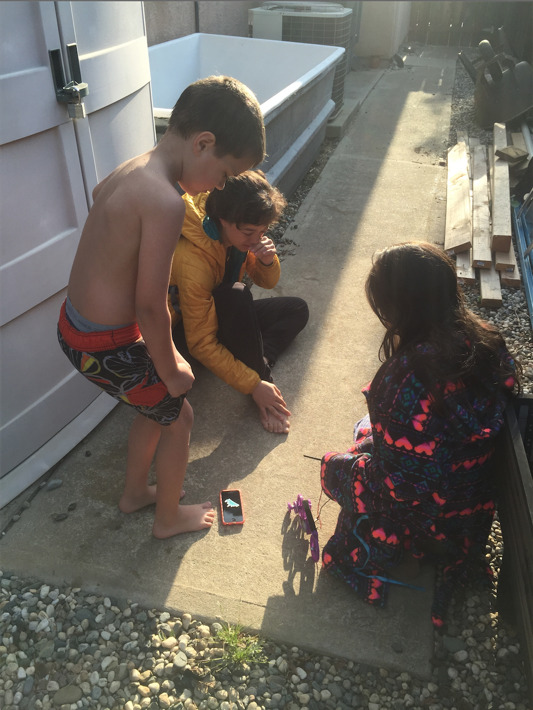
They loved it, and christened the purple one “Sunny”. Some of their feedback afterwards:
“Can we power the internet with the sun” “I want a roller coaster outside powered by the sun!”
That’s all for now, stay posted for our day-by-day updates. Happy Earth Day!
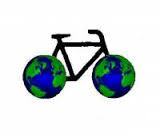
1 note
·
View note
Text
Teacher Profile #1: Becca Rolon

By Rachel
Name: Becca Rolon Age: 26 Years of teaching experience: 1 Class(es): 7th grade life science, 8th grade earth science, 9th grade physical science, 10th grade biology, and high school environmental science School: Cambridge Jr./Sr. High Town: Cambridge, ID (population 315)
Our first teacher profile is really an inspiration and model for our entire trip. Becca is a role model of mine – she has motivation, dedication and fire in her heart – and is a huge part of why I want to bike across the country and teach science. Here’s why:
I first met Becca while studying in Spain three years ago. We frolicked around Ronda, a breathtaking Malagese city that towers above a rocky canyon. I knew immediately there was a special spark in her – as the rest of la gente hid sheepishly under their umbrellas, she danced and pranced and soaked up the dripping rain, all the time with eyes wide open and a beaming glow across her face.
Then we returned from Spain… I went back to school, but Becca zipped off to adventure after adventure: first to the Netherlands, and then to Guatemala. Then in March 2013 she quit her “boring desk job” and hopped on her $300 hybrid Trek to ride SOLO across America. Becca was the first person I knew to do this trip, and I was hooked. She was one of the only reasons I kept my derrrn ol’ facebook account, and I was lucky enough to follow her along through her inspiring posts.
From Solo Cyclist to Solo Science Teacher
Just two years ago, Becca was a nutritionist back in her hometown of Raleigh, NC. So, uh, how did she become the only middle and high school science teacher in a teeny tiny farming town in rural Idaho?
The answer, of course: her bicycle lead her there! On her cross country trip, during a pit stop in Idaho to go bungee jumping, she accidentally fell in love (oopsy!)... so after her 4,000 mile, 75 day trip, she returned to Idaho to live with Forrest near a forest. Fast forward a year and another challenge zooms her way -- although she’d never taught any sort of class before, she had her bachelors in science and it soon struck her:
Being a science teacher, man? That sounds like something I can do!
So she applied to teach at Cambridge Jr/Sr High last August (2014), and in less than a month started the semester.
I spoke with her in January to learn about her teaching experience and some of the challenges she faces every day. We talked for four and a half hours. This is a condensed (and slightly edited) version of our conversation.
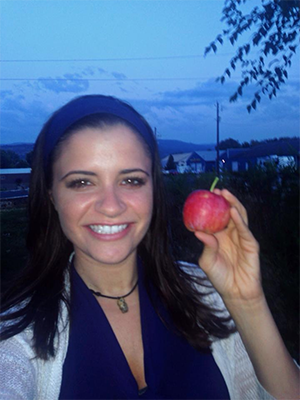
So, what’s it like to be ‘Ms. Rolon’?
I love it. It is so rewarding to be a teacher. But it’s hard. You’re trying to engage kids. You’re trying to get them to understand something they’ve never heard before. You’re trying to get them to learn it and master it. And [that mastery] is not easy, especially in a small school district. There are an average nine students in each of my classes, and only one science class per grade. At bigger schools, teachers teach the same lesson all day long. But for me, I am the science department. Every single hour is a new class. It can be overwhelming, but I never have to teach the same thing over and over and get bored of it.
What sorts of activities do you find engage your kids the most?
I would say a lot of hands-on activities. I am the teacher who has art all over. I actually have an art wall in my room, and outside I’ve got two doors completely covered in posters. I give my students an opportunity to do projects on their own and then present them, so kids get to listen to other kids [reiterate the concepts I’ve taught]. By putting it on the wall, kids from other classes will ask questions.
Last semester, I had a science joke-of-the-day and the kids loved it. I started thinking, can I do something more educational with this? Now I have a “Did You Know?” of the day, where I write a new science fact on the board, and the kids read it every day and ask questions. I need to be able to back them up when they ask a question, so I have to do outside research and it challenges me too.
And I do labs. Kids love labs. It doesn’t even matter what we’re doing a lab on. I could have them go in there to examine poop. If I tell them ‘we’re doing a lab today,’ their eyes light up. We do labs at least once a week in each of my classes. And actually this week we did two labs. But they are really demanding. And the kids always want more. (example below)
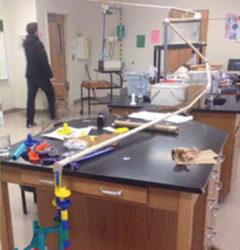
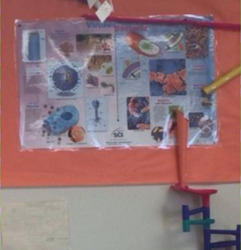
"Physical Science: The assignment, Marble in Motion, using a marble and any materials from home or in class--Construct a model to demonstrate all 3 laws of motion, 3 forms of friction, and a change in velocity. This was an awesome hands on approach. My students had a fun time with it!"
It’s so cool you do so many labs! How do you get all the supplies you need? Grants?
(chuckles) I’ve applied for grants. I didn’t really at first because I was so overwhelmed [with being a new teacher]. I just started applying, but I haven’t got anything. From the school we get $200 per teacher. We only get $200 a year.
$200 a year!!?? What can you buy with that? Staplers?
Yup. It is a challenge to budget supplies with a smaller fund. Our school’s been around since 1940, so we’ve got a lot of chemicals sitting in the chemistry closet. I have to go in there and just find stuff. I had the kids grow alfalfa in my classroom. And the alfalfa seeds – I just found them! But I buy a lot out of my own pocket. I would love to find some kind of organization that’s like: “hey, you are working in a very small, rural town? Let’s supply you with a brand new science classroom.” You know, that’s what we need. We need it.
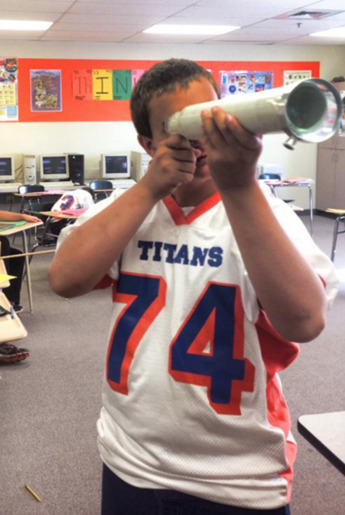
She barely has any funding, but rounded up enough to make home-made telescopes for her 8th graders!
Are you doing anything to address the funding issue?
I had the kids in environmental science make homemade soap. That was actually a really cheap project. I bought the lye. Then I went to a local butcher and he gave me pig fat, and I had kids who had killed their animals bring in their fat, and we boiled it all down and mixed it together. In the future I’m going to have kids make soap, and then we’re going to sell it to bring back money into the science program.
I’m also going to have them grow chicken eggs. In this community, people will buy chickens and slaughter them themselves, so this way we’ll create products that people will actually want. Each class is going to be selling their own products, and then with the money they make they get to decide what kind of science projects they want to do. So it will be an incentive for them to want to work harder.
But the grants... It’s just hard. There are a million teachers competing for the same grants. I think that’s the problem—people want better teachers, but they are not willing to budget the amount of funding required for the resources for the classroom.
Teaching in Rural Idaho
I understand Idaho has not signed on to the Next Generation Science Standards. What are your science standards like?
Idaho provides the standards, so we have points we have to cover within the year. But they’re very vague. We’re supposed to teach, for example, “organization systems” – there are so many different systems, how do you talk about “systems”? Are they within the human body? Or are they talking about the systems within the animal kingdom? Be more specific!
But they’re not. It’s very frustrating. What they hear in my biology class, they might not get in another, and if they are ever given a standardized test, then they might not do well on it. Not because they didn’t learn anything, but because they learned a completely different section of science because that’s the way the teacher interpreted it.
Do you teach evolution? Is that part of your curriculum?
Yes, I teach that in biology as well as 7th grade life science. The kids have to learn about different characteristics of life, and why animals evolved, and how they evolved. We don’t go into depth about human evolution because we live in a very conservative community. I kind of vaguely went over monkeys. I taught about how animals adapt and survive, and through that adaptation they slowly evolve. The “monkey thing” is a very sensitive subject. I taught them about Lucy, but it was a very odd subject for them. They thought she was alive. I showed them a picture of her the next day and they were surprised she was all bones.
What’s the school environment like?
I am the youngest and newest teacher at my school. I’m 26, the teacher next to me is 30, and a large majority of the staff has been teaching for over 15 to 20 years. And a big majority of the staff went to Cambridge (the school Becca teaches at, not that one school in Cambridge, MA). So I’m completely new. And I’m from a different state, that part’s kind of weird.
How does the community affect the way science is taught?
It’s a farming community. They don’t desire homework. It is common for kids to miss school to work on their ranch. They work hard labor on their land. The amount of labor that my students tell me they do on the weekend is unbelievable. It is remarkable though, kids that young are learning strong working ethics.
Also, because it’s such a small school, the kids who want to be challenged are in the same class as kids with special needs, and they’re learning the exact same subject and doing the exact same activity. When do you go back and reteach something, and when do you have to move on?
How do you deal with this?
Next year, I’m going to create an honors program for high school students in the same classroom setting. They will have a higher standard of assignments and projects. This is a way for me to push the self-motivated students further in their academics. It’s fine – college is not for everyone, it really isn’t. But for the kids that want to go to college and want to do something further, I’m going to be there for them.
My primary job is a science teacher. But I think being a teacher is so much more. You’re being a role model, and you are showing kids that there is so much to life. I feel so gifted to be a part of their lives. Not only am I their teacher, but I will also be there to be their mentor. I want to help them. I really care. I really do. Sometimes they know how to get under my skin, but I truly enjoy every one of my kids.
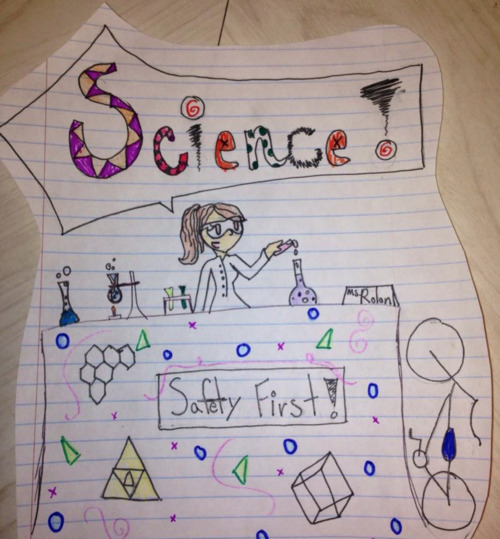
She gets her students excited about science! Here's proof, drawn on day two of her class by one of her students.
I had a kid tell me he knows everything he wants to do with his life, so he wants to drop out of high school. It’s awesome he’s thinking about what he wants to do -- but I suggested he think about how much more he has left to learn. I’m 26 and I’m still figuring out what I want to do with myself. You’re never ever going to figure it out completely.
And that’s the best part about having options. If I didn’t have my college degree, I would not have as many options. And that’s what I’m always stressing. Do everything you can to graduate high school. Have as many options as possible. Go to college. Travel. Meet new people. Go on that adventure that everyone tells you that you can’t do. Do it! Because, imagine the possibilities! I am living in Idaho. I am a science teacher! I never ever thought I’d do this. I never would have done this if I hadn’t got on that bike. You never know. You’ve just got to step out of your comfort zone and you have to try new things! If you don’t like it, try something else! I think that’s been my biggest lesson.
----
Want to hear more from Becca? Stay tuned, we’ll be posting her favorite lesson plans shortly. We'll also be stopping in Cambridge to teach in her classes in mid May and snagging her for a few days to be our Idaho bicycle tour guide!
0 notes
Text
BLAST OFF!
Breaking news from the murky corner of a Sacramento coffee shop: we just launched our Indiegogo campaign for Cycle for Science!!! After three mostly sleepless nights of spastic typing and video editing, we’ve finalized our goals and the campaign is live.
As a recap -- in exactly two months, Elizabeth and I are bicycling from San Francisco to New York City. As we zoomzoom across the US, we’ll be stopping in middle school classrooms to teach science lessons and to interview science educators. We’re designing the “Sol Cycle” – a 3d printable, solar powered bicycle demo – to teach about renewable energy and physics, and to make our project possible we need some help covering the costs to print this and to document teacher’s stories.
Check out our full campaign here!
youtube
We also did our third teacher interview today! Sneak peak: this amazingly driven woman saw a need, and single-handedly started robotics and programming electives at her middle school! Stay posted for upcoming blog posts about her and the inspiring teachers we’ve spoken to so far.
0 notes
Text
Just a few quick groans for the morning...
NYT's the Upshot published an article earlier this week:
"How Elementary School Teachers' Bias Can Discourage Girls from Math and Science"
Okay so at first, I read through this, and I was like: of course. Of course we have unconscious biases and those of elementary school teachers tend to line up with society's.
But this study is actually kind of weird: it shows that:
"Beginning in 2002, the researchers studied three groups of Israeli students from sixth grade through the end of high school. The students were given two exams, one graded by outsiders who did not know their identities and another by teachers who knew their names.
In math, the girls outscored the boys in the exam graded anonymously, but the boys outscored the girls when graded by teachers who knew their names."
So, huh? How do biases affect scores on math and science tests? There isn't much interpretation involved in those answers. Also grouping 6th grade with elementary school is a stretch. I've requested media access to the article; hopefully I can find out.
0 notes
Text
The Teachers Who Make Us
This is what the internet was made for. Brandon Stanton started profiling and photographing New Yorkers some five years ago, founding Humans of New York (HONY). Millions now follow his work, because he manages to tease out the most compelling, earnest, honest, wrenching stories from the strangers he meets. A couple weeks ago, he ran into a kid named Vidal, and asked him about someone who made an impact on his life.

Stanton “Who’s influenced you the most in your life?” Vidal “My principal, Ms. Lopez.” Stanton “How has she influenced you?” Vidal “When we get in trouble, she doesn’t suspend us. She calls us to her office and explains to us how society was built down around us. And she tells us that each time somebody fails out of school, a new jail cell gets built. And one time she made every student stand up, one at a time, and she told each one of us that we matter.”
http://www.humansofnewyork.com/post/108621363306/whos-influenced-you-the-most-in-your-life-my
Brandon encouraged his followers to donate to a fund that would allow the school to take their kids to Harvard. To date, the public has a raised over a million dollars, enough to set up that field trip for perpetuity, as well as provide scholarships for deserving kids like Vidal. And just this week a picture went up of Vidal and Ms. Lopez were invited to the White House.

This woman is a national hero:
“This is a neighborhood that doesn’t necessarily expect much from our children, so at Mott Hall Bridges Academy we set our expectations very high. We don’t call the children ‘students,’ we call them ‘scholars.’ Our color is purple. Our scholars wear purple and so do our staff. Because purple is the color of royalty. I want my scholars to know that even if they live in a housing project, they are part of a royal lineage going back to great African kings and queens. They belong to a group of individuals who invented astronomy and math. And they belong to a group of individuals who have endured so much history and still overcome. When you tell people you’re from Brownsville, their face cringes up. But there are children here that need to know that they are expected to succeed.”
Had any teachers or educators that made an impact on your life you'd like to celebrate? Let us know at [email protected]. We'd love to hear your story. And Rachel and I will post memories of some of our favorites in the weeks to come.
0 notes
Text
"Be a Scientist" Day 1

By Rachel
Time for me to do my first batch of scribbling in this bloggity blog! Actually I think this is the first time I've ever written in a blog. And yesterday, another first -- I taught in a middle school classroom for the first time.
Gulllp.
I’m volunteering in the pilot of “Be A Scientist,” an outreach program with the Community Resources for Science (CRS). A little plug for CRS -- they are an amazing Berkeley-based organization that aims to connect scientists, educators and students and provide an array of resources to help excel science education. Er, I’ll let them say it:
Our goal is simple: help teachers give students more opportunities to “do science” – to ask questions, test ideas, get their hands on real science activities. We need to inspire the next generation of thinkers, makers, problem solvers, and leaders!
One of their most widespread programs, BASIS (Bay Area Scientists in Schools), brings scientists, mostly graduate students and post-docs from UC Berkeley, into elementary and middle schools to teach interactive, hands-on lessons. BASIS has had some remarkable success -- last year (2013-2014), 500+ BASIS volunteers visited 416 Bay Area classrooms, presented over 100 different hands-on lessons, and reaching over 10,000 students. Teachers love it -- each BASIS lesson was crafted to fulfill a specific state teaching standard, and they bring new perspectives to students about what science means.
Graciously, BASIS allows grad-school-procrastinators like myself go too. I’ve been visiting elementary school classrooms this year to teach interactive lessons on renewable energy. Last time we went to a third grade class. It was challenging to introduce the idea of renewable energy to the class, let alone the concept of “renewable” -- we asked for examples of renewable things, and the students kept saying “shoes! Cuz you can go buy more!” We used a solar powered buggy demo, I guess a twice removed (since there are two more wheels?) cousin of our little infant Sol Cycle.
“Be a Scientist” is a bit different than BASIS. Rather than giving just one lesson over one class period, the same volunteers come into the same 7th grade class six times during the semester. Here’s the low down: every single student is designing, carrying out, analyzing, and presenting their own testable scientific experiment over the course of a month and a half. The idea is to introduce the scientific method to the students, coach them throughout the creative process, and relate it back to what we do in our own research projects. It was founded by Mary C. Wildermuth, a UC Berkeley Professor of Plant & Microbial Biology (stay posted peeps, we’re trying to line up a teacher profile with her!)
I walked into Mr. C’s classroom and immediately my eyes zipped around between dioramas of planets, bright posters all over the walls, and … to the gecko geckoing around in his gecko in the back corner! It was clear this teacher had worked really hard to create a comfortable, vibrant space for his students to learn at their fullest.
There were five other volunteers in my class. We started off giving quick overviews of our own research. I pulled the whole “I shoot giant six-foot lasers at stuff to make other stuff, KAPOWWW” line, and attempted to explain transparent conducting materials and their relevance in everyday devices: iPhones, LED disco dance displays, flat screen TVs, and -- the ultimate, la crem de la crem -- solar energy conversion. Other volunteers were from many different research areas, and talked about particle physics, nuclear physics, robotics, chemistry, biology, etc.
The students had so many o’ question. So many that the “quick” intro ended up taking up half the class period, leaving less time to break out into groups. Some highlights: “What is a grad student?” “How much money does Berkeley have? Does it get it from Football? Why do some schools have more money than other schools?” “Is chemistry, like, the stuff in your brain?” “Wait, whaaat is your name?” “Do you do what my mom does?” and one memorable one directed to me: “Do lasers make you blind, like, forever forever?”
For the rest of the class, I led four students in a discussion to brainstorm separate research projects for each of them. It was trickier than I’d thought. We need to come up with four experiments that are stimulating, challenging, and suited to the student’s interest, and the constraints are heavy -- materials must be very cheap and the experiment must be feasible to complete in two class periods. The ol’ mentos and coke gag is off limits. And experimenting on animals is discouraged. So of course, my two most students immediately decided they wanted to work with mice (putting them in solitary confinement and in the dark!?) and with hamsters. Multiple. I tried to gauge what each of their general science interests were -- neuroscience, computer science, electricity, and “um nothing” -- and redirect these interests into testable questions not involving mice. We didn’t get too far, and the questions are very much under construction (just like the UCLA campus always is!) but here’s what they might be doing:
How does the power output vary between batteries made out of different kinds of fruits and vegetables? Why? Bonus project: how can we hook up these batteries to charge an iPhone? (this student initially wanted to charge an iPhone with mulitple hamsters on a treadmill -- the teacher said we could do that if his parents provided the hamsters. I wished him luck)
How do humans react to being in darkness for varying periods of time? (We’re still having some trouble defining the dependant variables ... this student wants to do this on mice, and is trying to pull the “Hey mom can you buy me seven mice” card. Again, sent some luck)
How does the electronic resistance vary in different materials? How does it change when you heat them up? (I might be able to bring some semiconductor materials from my lab… thinking silicon, some metals, maybe something I’ve synthesized... might change the thickness, might measure transparency to try to squeeze in a lesson on transparent conductors?)
What percentage of students can differentiate the taste of similar-textured foods when their sense of smell is eliminated? Nose-plugs are quite as hard to come by as hamsters, and are provided by the CRS. We’ll run the typical “potatoes vs. apples”, and come up with some others. We might use the same foods as the battery experiment.
I had a tough enough time talking with four students, and keeping all of their interest while narrowing each of their interests. At one point we had to take a break, and so we took the gecko out of its cage so I could explain the suction mechanism on its feet. After just a half hour of brainstorming, I was exhausted. Yet Mr. C used to do this same project every year for twenty years with NO help, in the same time frame. That means seven times as many kids as I was helping, and making sure each one of the 30 students has a project that is both exciting and practical. And then teaching six other classes of the same thing. That’s a whoppin’ 180 different science experiments.
Anyways, this was the first of six visits I am so excited to see how these projects evolve and I’m lucky to have the support of CRS throughout the process. I’m trying to drag Elizabeth along with me for a few classes (my avid readers: that’s where you come in! Start spam emailing Elizabeth to convince her to come with me! Okay fine, she has a super busy schedule because she just got into a bunch of PhD programs and has to, ya know, get flown all over the country so they can convince her to come work on piezoelectric devices...)
Sasha and Elise from the CRS are also oh so kindly helping us plan our Cycle for Science lessons -- so stay tuned for many more CRS-related updates from ovah here!
0 notes
Photo

We have a domain name! Feeling like real adults, and also like this project is really starting to come together.
0 notes